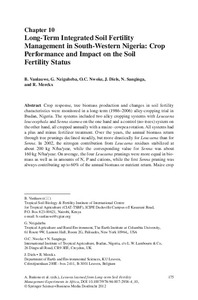| dc.contributor.author | Vanlauwe, Bernard |
| dc.contributor.author | Nziguheba, Generose |
| dc.contributor.author | Nwoke, O.C. |
| dc.contributor.author | Diels, J. |
| dc.contributor.author | Sanginga, Nteranya |
| dc.contributor.author | Merckx, R. |
| dc.date.accessioned | 2019-12-04T11:07:54Z |
| dc.date.available | 2019-12-04T11:07:54Z |
| dc.date.issued | 2012 |
| dc.identifier.citation | Vanlauwe, B., Nziguheba, G., Nwoke, O.C., Diels, J., Sanginga, N., & Merckx, R. (2012). Long-term integrated soil fertility management in South-Western Nigeria: crop performance and impact on the soil fertility status. In A. Bationo, B. Waswa, J. Kihara, I. Adolwa, B. Vanlauwe and K. Saidou, Lessons learned from long-term soil fertility management experiments in Africa (pp. 175-200). Dordrecht: Springer. |
| dc.identifier.isbn | 978-94-007-2937-7 |
| dc.identifier.uri | https://hdl.handle.net/20.500.12478/1642 |
| dc.description.abstract | Crop response, tree biomass production and changes in soil fertility characteristics were monitored in a long-term (1986–2006) alley-cropping trial in Ibadan, Nigeria. The systems included two alley cropping systems with Leucaena leucocephala and Senna siamea on the one hand and a control (no-trees) system on the other hand, all cropped annually with a maize- cowpea rotation. All systems had a plus and minus fertilizer treatment. Over the years, the annual biomass return through tree prunings declined steadily, but more drastically for Leucaena than for Senna . In 2002, the nitrogen contribution from Leucaena residues stabilized at about 200 kg N/ha/year, while the corresponding value for Senna was about 160 kg N/ha/year. On average, the four Leucaena prunings were more equal in biomass as well as in amounts of N, P and cations, while the first Senna pruning was always contributing up to 60% of the annual biomass or nutrient return. Maize crop yields declined steadily in all treatments, but the least so in the Senna + fertilizer treatment where in 2002 still 2.2 t/ha of maize were obtained. Nitrogen fertilizer use efficiency was usually higher in the Senna treatment compared to the control or the Leucaena treatment. Added benefits due to the combined use of fertilizer N and organic matter additions were observed only for the Senna treatment and only in the last 6 years. At all other times, they remained absent or were even negative in the Leucaena treatments for the first 3 years. Most chemical soil fertility parameters decreased in all the treatments, but less so in the alley cropping systems. The presence of trees had a positive effect on remaining carbon stocks, while they were reduced compared to the 1986 data. Trees had a positive effect on the maintenance of exchangeable cations in the top soil. Exchangeable Ca, Mg and K – and hence
ECEC – were only slightly reduced after 16 years of cropping in the tree-based systems, and even increased in the Senna treatments. In the control treatments, values for all these parameters reduced to 50% or less of the original values after
20 years. All the above points to the Senna -based alley system with fertilizers as the more resilient one. This is reflected in all soil fertility parameters, in added benefits due to the combined use of fertilizer nitrogen and organic residue application and in
a more stable maize yield over the years, averaging 2.8 t/ha with maximal deviations from the average not exceeding 21%. |
| dc.description.sponsorship | Fonds voor Wetenschappelijk Onderzoek, Vlaanderen |
| dc.format.extent | 175-200 |
| dc.language.iso | en |
| dc.publisher | Springer |
| dc.subject | Alley Cropping |
| dc.subject | Leucaena Leucocephala |
| dc.subject | Senna Siamea |
| dc.subject | Soil Fertility |
| dc.subject | Nitrogen Fixation |
| dc.subject | Soil Chemicophysical Properties |
| dc.subject | Fertilizer Application |
| dc.subject | Biomass |
| dc.subject | Dry Matter Content |
| dc.title | Long-term integrated soil fertility management in South-Western Nigeria: crop performance and impact on the soil fertility status |
| dc.type | Book Chapter |
| dc.description.version | Peer Review |
| cg.contributor.crp | Integrated Systems for the Humid Tropics |
| cg.contributor.affiliation | International Institute of Tropical Agriculture |
| cg.contributor.affiliation | Columbia University |
| cg.coverage.region | Africa |
| cg.coverage.region | West Africa |
| cg.coverage.country | Nigeria |
| cg.authorship.types | CGIAR and advanced research institute |
| cg.iitasubject | Integrated Soil Fertility Management |
| cg.howpublished | Formally Published |
| cg.publicationplace | Dordrecht, the Netherlands |
| cg.accessibilitystatus | Limited Access |
| local.dspaceid | 82598 |
| cg.targetaudience | Scientists |
| cg.identifier.doi | http://dx.doi.org/10.1007/978-94-007-2938-4_10 |


